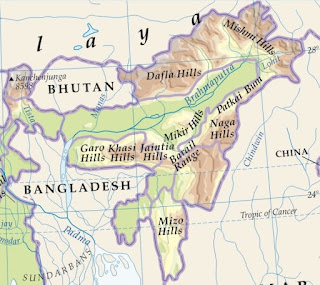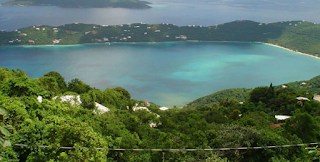The Barail Range is a group of mountains or high ridges and watersheds between the Brahmaputra and Barak rivers. The terrain ranges from flat and undulating in the river valleys, to mountainous with steep slopes. Located in the Dima Hasao district of Assam a state of India (Latitude: 25° 16' 27" N - Longitude: 93° 20' 51" E)
Geography of Barail Range
The Barail range is a
tertiary mountain range topographically bridging the Archaean Meghalaya Plateau
with the tertiary Naga Hills which is the south-western projection of the Himalayas.
The Barail hills of
Assam covering the N.C Hills district are the westward continuation of the
Barail range stretching from Tuensang across Nagaland.
The Barail range
divides the N.C Hills into two parts-the northern part falls under the
Brahmaputra basin and the southern part falls under the Barak basin.
The range rising from
300 m in the southern part of the Karbi plateau attains a maximum height of 1866 m
in the Theipibung peak of the N.C Hills district.
The other notable peaks
of the Barail range are the Hemeolowa (1679 m), the Mahadeo (1739m), the
Kaukaha (1736m), and the Tukbai (965m) peaks. The southern range of the Barail
range is steeper than the northern face due to faulting.
The north-flowing rivers like Kopili and Dhansiri and their headstreams had dissected the range by their headward erosion and thus have subdued the northern face to lower elevations with gentle slopes.[1]
The Barail Range is another important mountain range in Nagaland, It enters the State from the North Cachar district of Assam and after passing through Kohima area runs towards the north of Kohima. Japvo, which is located a few kilometers south of Kohima is the highest peak of Barail Kange.
It attains a height of 3,014 meters above mean sea level, here the range is met by a complex hilly range prolonged from the Arakan Yoma (the dominant mountain system of Burma}, and from the is point the main range runs in a north and northeasterly direction.
The Barail Range is connected with the Patkai Range through small ranges. One of these ranges connects them in the vicinity of Kohima. Up to Mao (Manipur), it runs in a southeast direction and from there the range assumes an eastward trend and runs for a few kilometers until it follows s a southward direction. [5]
Geology of Barail Range
The Barails are grey to brownish color sandstone of fine to coarse grain size. The term Barail was first coined by Evans (1932). They are usually alternations of shale and sandstone giving rise to a typical turbidite character.[2]
The main rock types found in the Barail Group are well-bedded sandstone, shale, clay, and coal. The Barail rocks are followed by an unconformity over which the Miocene Surma Group of rocks is deposited.
The Barails are mainly confined to the ’Belt of Schuppen' in the outer hill areas and also crop out as outliers over Disangs in some high ridges in the intermediate hill areas. The main rock types found in the Barail Group are well-bedded sandstone, shale, clay, and coal.
The Barail rocks are followed by an unconformity over which the Miocene Surma Group of rocks is deposited. The Surmas are exclusively confined to the 'Belt of Schuppen' and are also molassic sediments of sandstone, shale, and clay.
The Tpam Group of rocks which conformably overlie the Surmas are mainly confined to the 'Belt of Schuppen', though they also occur sporadically in the eastern high hill areas where they unconformably overlie the Disangs. [6]
The end of the Eocene is marked by the swallowing of the geosyncline and the formation of second-order troughs and geanticlines. In these rhythmically sinking shallow basins, the argillaceous-arenaceous Barail Group of sediments was deposited. Intermittent sub-aerial conditions led to the formation of the at presently exploited coal seams within this Group.
An equivalent of this Group is also seen in the plateau. The end of the Oligocene was marked by the emergence of the Barail Group of sediments, (present North Cachar Hills) and most parts of the Upper Assam platform. Corollary to this dynamism, certain local basins were also formed wherein the argillaceous-arenaceous Surma Group of sediments were deposited.
In this period there developed
tensional and compressional tectonism which may be earmarked as pre-and-post-Barail.
The Belt of Schuppen is a product of post-Barail tectonism. The Upper Miocene
was marked by the upliftment of the Naga-Patkai-Lushai Hills and the Eastern
Himalayas with paripassu sinking of the foredeep and the intermittent troughs
where the Tipam Group of sediments was deposited.
During Mio-Pliocene
times, further upliftment of the Shillong Plateau against the Dauki Fault
resulted in the unconformable deposition of the Dupitila rocks Intermittent reactivation
of some criss-cross faults in the platform towards the end of Miocene led to
the activation of the Naga-Patkai ranges in the east.
This led to the formation of shallow lacustrine and fluviatile basins where the Dihing Group of rocks was deposited. Intense orogeny and rapid sinking of the beds led to the pebbly nature of the Dihing rocks Unconformabiy overlying the Dihing rocks are the Quaternary alluviums in the name of Bhanger and Khader which represents the final stage of Himalayan orogeny.[3]
Biodiversity of Barail Range
The Barail Range forms
one of the most diverse, but lesser-known, ecosystems of the region. The great
altitudinal variations (from less than 100 m to towering peaks of more than
1,900 m) and the resultant diversity of vegetation, coupled with a rich
faunistic composition makes the area an ideal choice for a wildlife reserve
and an IBA. The Barail is the highest hill range in Assam.
It includes the North
Cachar Hill Reserve Forest (RF) of the Cachar district, Barail RF of the Cachar and
North Cachar Hills districts, and the unclassified forests stretching from the
Simleng river valley in the west to Laike in the east (in North Cachar Hills
district).
The high bird
diversity of the Barails was documented long ago The only known population of
Blyth’s Tragopan Tragopan blythii in Assam is in the extreme east of the
Barails near Laike. The only known breeding site of the Cinereus Vulture
Aegypius monarch tenuirostris in Assam was also in the Barails.
The Lesser Adjutant
Leptoptilos javanicus is seen in the southern valleys, while there are past
records of the Swamp Francolin Francolinus gularis from the southwestern fringe
(Choudhury 2000). The site covers two biomes: Biome-8 (Sino-Himalayan
Subtropical Forests) at c. 1,000 to 2,000 m and Biome-9 (Indo- Chinese Tropical
Moist Forest) mainly below c. 1,000 m. BirdLife International (undated) has
listed 95 species in Biome-8, of which nine are found here.
Two out of nine species
listed in Biome-9 are also present. Both are quite common in Tropical Moist
Forests. As can be expected, some species of other biomes are also found,
mainly as winter migrants.
The Barail Range has rich mammalian fauna. Seven
species of primates are found, these are Slow Loris Nycticebus coucang,
Stump-tailed Macaque Macaca arctoides, Assamese Macaque M. assamensis, Rhesus
Macaque M. mulatta, Pigtailed Macaque M. nemestrina, Capped Langur
Trachypithecus pileatus, and Hoolock Gibbon Hylobates hoolock.
Other mammals include the Asiatic Black Bear Ursus
thibetanus, Tiger Panthera tigris, Leopard P. pardus, Clouded Leopard Neofelis
nebulosa, Jungle Cat Felis chaus, Leopard Cat Prionailurus bengalensis, Golden
Cat Catopuma temminckii, Marbled Cat Pardofelis marmorata, Wild Dog Cuon
alpinus, Sambar Cervus unicolor, Muntjak Deer Muntiacus muntjak, Wild Boar Sus
scrofa, Binturong Arctictis binturong and the Serow Nemorhaedus sumatraensis.
Small populations of Gaur Bos frontalis also occur. Asian Elephant Elephas
maximus is locally extinct now.
Common reptiles include various species of lizards and snakes throughout the site. The Brown Hill Tortoise Manouria emys is also met with occasionally.[4]


